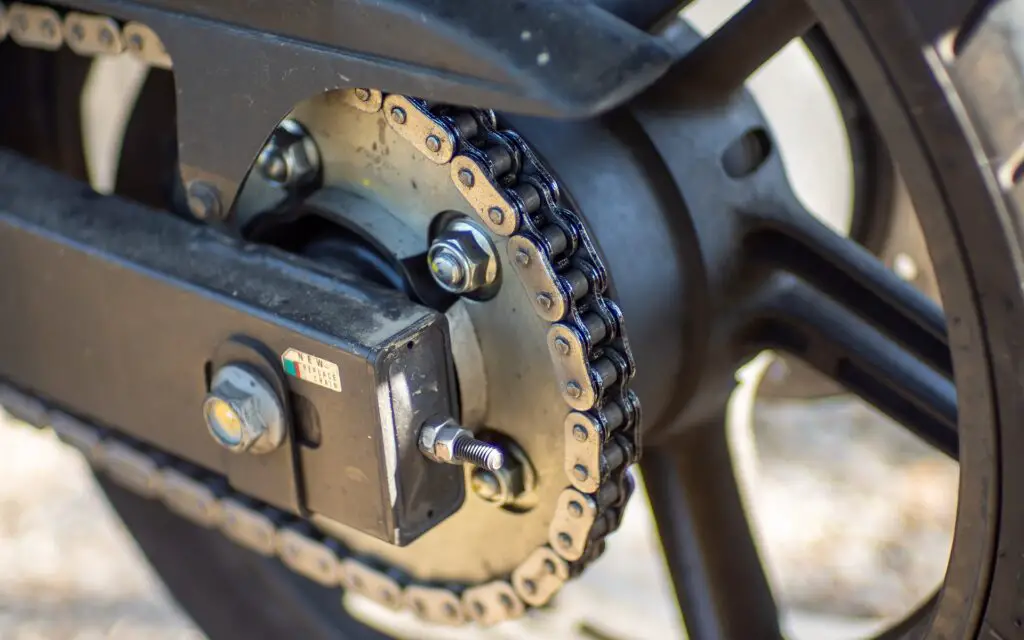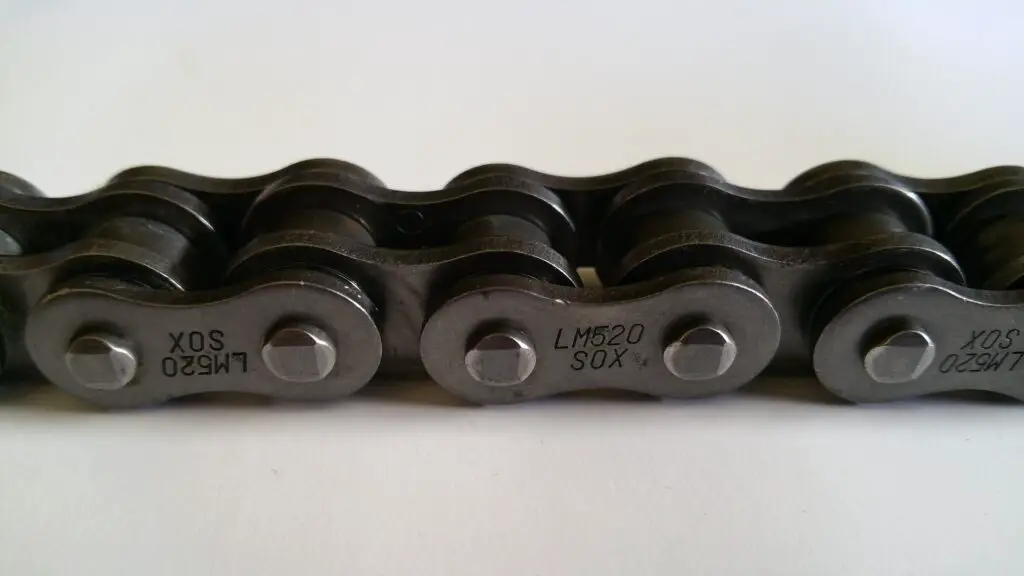There are a lot of factors that go into motorcycle maintenance, but some are easier to manage than others. Learning to master some important motorcycle care like changing your oil, cleaning your bike, and lubing the chain can make all the difference in the life of your ride. With this guide, you can increase the longevity of your chain and, with it, your motorcycle.
Motorcycle chains need to be regularly lubed in order to increase their lifespan. Lube reduces wear, prevents rust, and stops dust and grime from gunking up your chains. It’s important to make a habit of cleaning and lubing your motorcycle chains.
This is the easy answer. However, things can get a little more complicated when it comes to choosing the correct lube and figuring out how and how often to lube the chains. Don’t worry, though! It isn’t as difficult as it might seem, and the most important thing is just to use some kind of lube to keep your chains in prime condition.
How important is it to lubricate motorcycle chains?
The chain is an essential part of a motorcycle. Not only does it keep the wheel spinning, but it also allows you to change gears. The bike can’t function without it. In order to make sure that your chain lasts through the years, you’ll need to take the time to maintain it. One of the main steps in chain maintenance is lube.
Lube is a wax or oil-based substance meant to provide a buffer around the chain to ease contact between the sprockets and the chain roller, to reduce friction, and to provide resistance against water and dust. This protection drastically increases the life of your chain and sprockets. It slows down the effects of wear and tear from your riding, and it prevents rust and corrosion.
Many modern motorcycles come with sealed chains. O-ring, X-ring, and Z-ring chains all have a seal to keep out grime, unlike plain roller chains with no contact between the metal rollers.
There’s a common misconception that sealed chains don’t require lube, but this is a false assumption! Although you no longer need lube for the internal parts of the rings, you still need to protect it from external friction and debris.
With lube, the external pieces of the chain are protected from the constant friction caused by riding. This drastically increases longevity, since it reduces wear of both the chain and the sprockets. But lube is also important because it acts as a barrier around the chain and makes it resistant to dust and water.
As I’m sure you know, water causes rust. Rust, in turn, ruins a chain. While lube isn’t an end-all cure-all, it will make the chain a little more water resistant and could save you from the discovery of a rusty chain and a sooner-than-expected chain replacement.
As far as dirt and grime go, I’m sure you also know that riding can be quite dirty. Many kinds of lube protect against the accumulation of dirt and other grime that may otherwise gunk up the chain, causing further wear and tear or leading to problems like uneven wear of the sprockets or even a broken chain.
While some people will claim to have ridden thousands of miles without using lube on their chain, this isn’t a risk worth taking. Many kinds of lube are easy and quick to apply and much cheaper than the cost of a new chain. By regularly taking the time to care for your chain by using lube, you’ll be drastically extending the life of your chain and your bike.

How often should you lube your chain?
If you’re still reading, hopefully that means I’ve convinced you on the need to lube. The next question might be “okay, but how much?” You don’t need to reapply lube after every ride, but you do want to lube up more than once a decade.
A good rule of thumb for a street bike riding in normal conditions is to lube your chain after riding 300 to 600 miles. If you ride in the rain a lot, you might want to use lube more often, and you may find that your chain can go a little longer without fresh lube.
After riding, especially if you’ve gone through a lot of water or dirt, you should make a habit of cleaning your chain along with the rest of your bike. This will also let you keep an eye on the chain and identify the need for additional lube. A chain that needs lube will appear dry and will probably have accumulated dirt. There may even be signs of corrosion, which will need to be carefully cleaned before you use lube.
Some things that might make you need to use lube sooner are water, excessive dirt and dust, or an older chain. You’ll also want to keep an eye out for flinging. Flinging is when lube is flung off the chain, usually at high speeds. If you notice flinging, it’s a good idea to reapply lube promptly.
We’ve put together a list of some highly recommended lubes that aren’t likely to fall off the chain, but it’s something to be aware no matter which lube you use.
Finally, some riders swear by using lube after any especially wet rides. If water has gotten into your chain, you’ll be able to extend its life by wiping it down, drying it off, and reapplying lube to prevent rust. Keep in mind that you probably won’t have any issues from overapplying lube, while you will come into problems from underapplying lube. When in doubt, lube it up!
Are there different types of lube?
We’ve briefly mentioned that there are different types of motorcycle chains. Plain roller chains have no seal between the metal links. O-rings and other sealed rings, such as X-rings and Z-rings, have a protective seal to keep grime and dirt out from between the rings. Both types of chain need regular lubrication, but the lube you use might change.
For an O-ring chain, you want a lube that is tacky and adhesive. The lube used on a seal chain is mostly meant to protect the exterior, so it needs to hang on and really coat the chain. In contrast, a plain chain needs a viscous lube that can seep into all the crevices and protect the hard-to-reach parts of the chain, not just the exterior.
There are a lot of different kinds of lube. And, as you begin your search for the best motorcycle chain lube, you’ll find that many people swear by, or against, specific brands and types. Ultimately, the lube you choose is your decision, as long as you are using lube.
- Wet lubes are highly viscous and cling to the chain well. However, they can be messy to use and may leave residue on the chain.
- Dry lubes evaporate after application, leaving behind a protective film. They are best for clean chains and dry riding, since they specially repel dust but may not be as water resistant.
- Spray lubes are less viscous but excel from easy application. They’re one of the easiest and quickest choices for applying lube to any chain, though it can be messy.
- And finally, paste lubes are thick, with deep penetration and good ability to stay on the chain. Paste lube takes more time to apply but can result in a neater and more consistent application.
When deciding which lube to purchase, you can ask your mechanic for tips or research what other rides with your same chain are using. In the end though, it might come down to a matter of preference.
If you aren’t sure where to start, we’ve included a section with some favorite lubes that have been highly rated to resist flinging, protect the chain, and keep away dirt and water. You can start with one of our picks as you journey into finding the best lube for you.

What is the best chain lube on the market?
Now that I’ve clarified that there are different kinds of lube and much of the decision is a matter of preference, I also wanted to provide a top five list of some of the best lubes on the market. These lubes are highly reviewed for different kinds of chains. They’re fan favorites and commonly used, for a reason!
1. PJ1 Blue Label (Amazon) lube is designed for sealed chains. It dries into a waxy film that will protect your motorcycle chains for years to come from dust and water. It’s a petroleum-based formula that prides itself in being long-lasting with low chance of flinging. PJ1 also offers a Black Label lube which is meant specifically for plain roller chains.
The spray application of PJ1 Blue Label is easy to apply. While the lube may drip during application, it won’t create the same mess of other lubes, and the nozzle makes it easy to direct the spray and avoid too much bike cleanup after use.
2. Maxima Chain Wax (Amazon) is another favorite for many motorcycle owners. It also boasts easy application and no fling. In addition, the wax formula prevents the spray that many oil-based lubes create for the first few rides after application.
Maxima Chain Wax is designed for sealed chains. Reviews herald its long-lasting formula and intense protection. The wax formula also provides excellent water-resistance, so it’s a great choice for riders who may be spending more time in the weather. In addition, Maxima offers a great combo pack with everything you need for cleaning and lubing your bike chain.
3. Motul Factory Line Chain Lube (Amazon) is another great motorcycle lube. It is compatible with plain and sealed chains and is a thick, tacky lube. The lube dries to a milky white, which makes it easy to spot any areas you may have missed.
The Motul Chain Lube provides a thick coating over your chain which will reduce friction. It was designed for road racing and doesn’t pick up dust and debris the way many lubes and oils do. It is easy to apply and stays on well, though it can be difficult to clean if you are messy during your application.
4. Motul also makes the Motul C5 Chain Paste (Amazon), which is a great choice if you prefer paste lube. You’ll need to spend a little more time applying this lube, since you’ll have to carefully apply with a brush instead of just spraying around the chain.
However, the result is a lube with high adhesion and very little fling. It works great for both wet and dry rides and thoroughly coats the chain.
5. DuPont Chain Saver (Amazon) is the final choice for a highly rated lube with good adhesion and water resistance. It’s focused on providing water resistance for bad weather rides. It also has good resistance against dust and gravel and can keep your chain from getting gunked up in riding.
In addition, the DuPont chain lube is easy to apply with minimal mess. It doesn’t fling easily but instead sticks to the chain for longer rides between reapplication.
How do you clean and lube your chain?
The final detail you’ll need to know about motorcycle chain lubrication is: How do you use it? If you’ve never paid much attention to the chain, you might not know how to approach cleaning and lubing it. Here’s a quick run-down.
First, you’ll need to clean the chain. It’s a good idea to start this process after riding, not before. You’ll have best results if you let the lube sit for a while before you ride, so it’s good to do this when you can wait several hours before riding again.
Start by wiping away dirt and debris with a rag. Remove any major grime before using and products to clean. When you do move on to a cleaning product, you’ll want one that won’t stop the lube from adhering. Products like kerosene are commonly used but not the best choice, because they leave a residue that affects the lube’s adhesion.
While you’re cleaning, take some time to inspect for wear. You want to make sure there isn’t uneven wear on the sprockets and check for corrosion on the chain. You should also check the tightness of the chain; make sure it isn’t too loose or being pulled too much.
Spray whichever cleaning product you’re using liberally. Use a chain brush to get into the tighter areas and scrub away accumulated grime.
Next, you’ll want to completely dry the chain using a cloth. Especially if you’re using kerosene to clean the chain, you need to remove all residue in order for the lube to stick. If you have time, I’d recommend waiting a few minutes between cleaning and lubing, just to make sure the chain is completely dry.
Now, it’s time for lube. If you’re using a spray lube, you can spray the inside circumference and lower run of the chain. Spray liberally! If using a paste lube, brush the lube over these same areas, making sure to fully coat the chain.
Depending on which lube you’ve used, you may need to wipe down the back of the bike again, since spray applications can be quite messy. Let the lube sit for at least a couple hours to allow it to sink into the chain and dry.
If you don’t wait, the lube will be flung over the back tire and back of the bike. Not only is this messy, but it also means that most of your lube will have been flung off, and you’ll need to reapply. However, if you do wait, the lube should settle in place with a minimal fling, and you’ll be set to ride for a few hundred miles, knowing your chain is in good hands and your bike is set for success.
